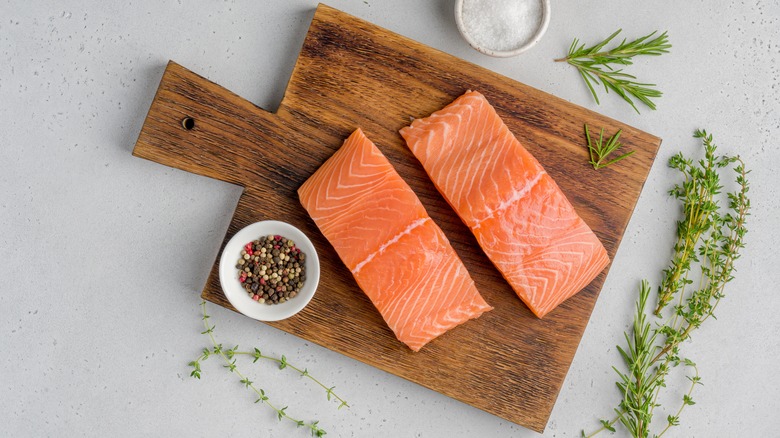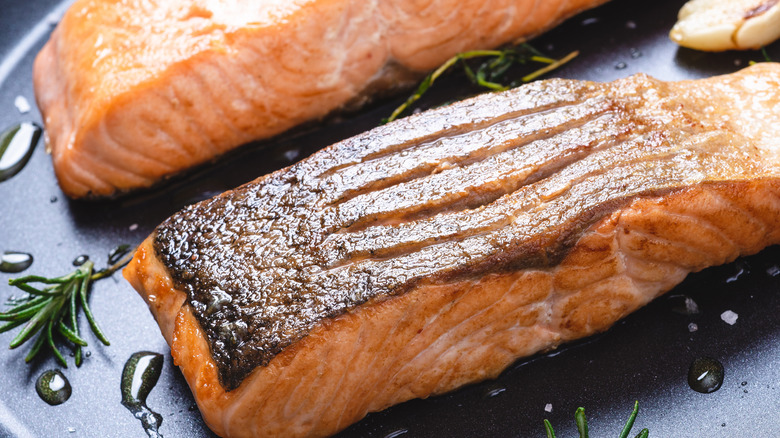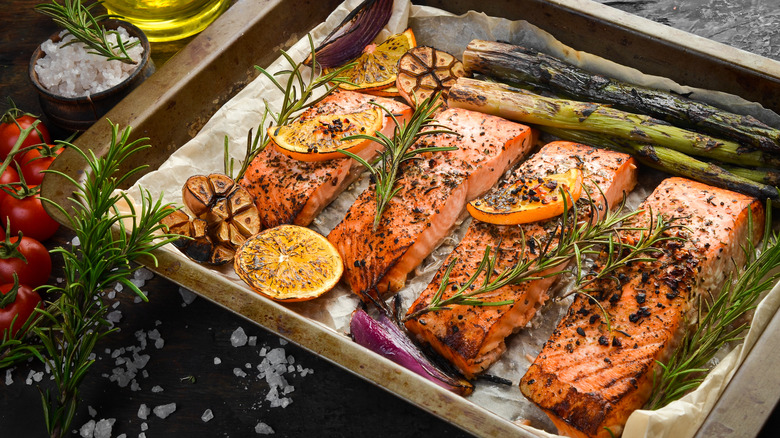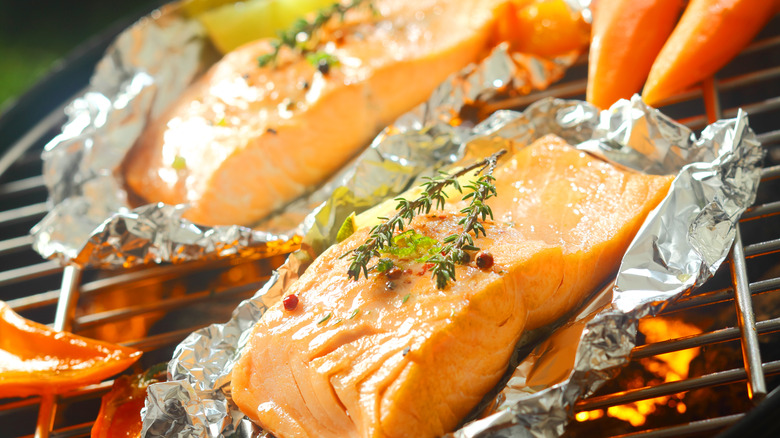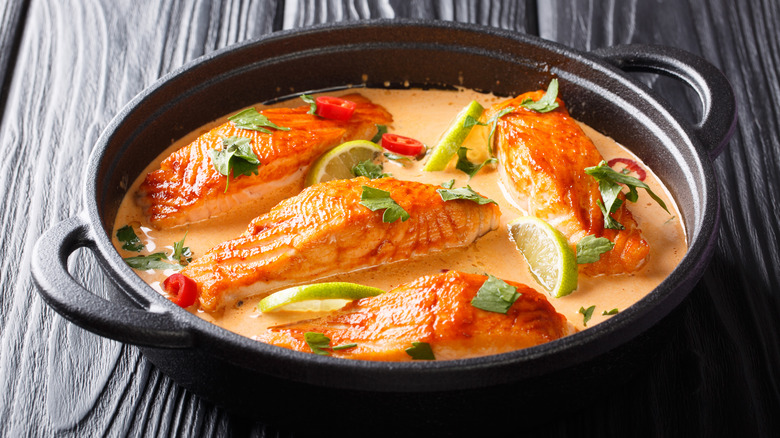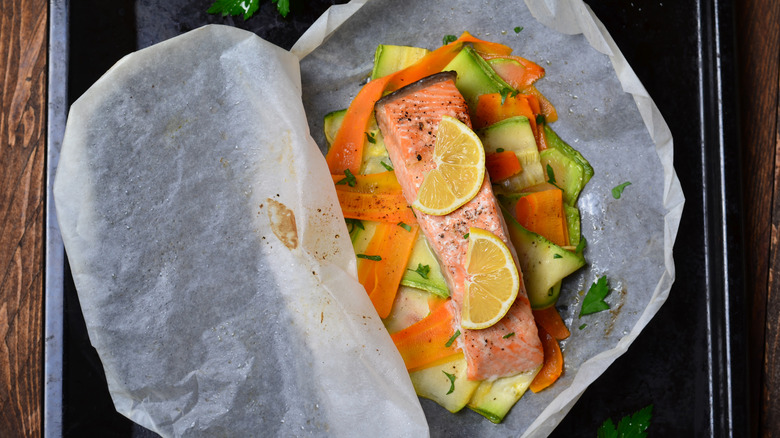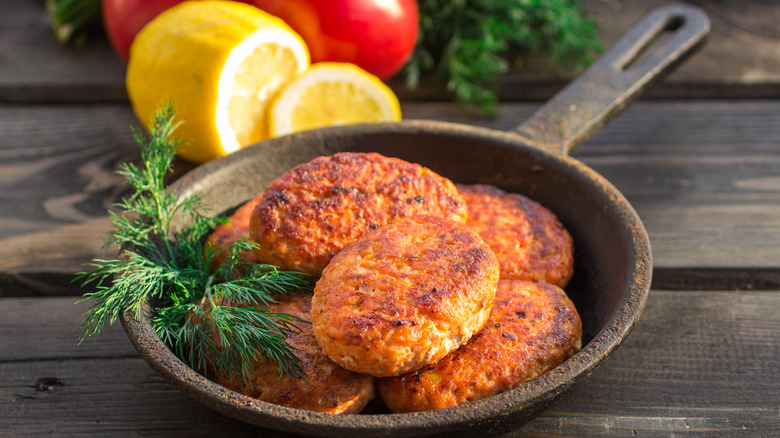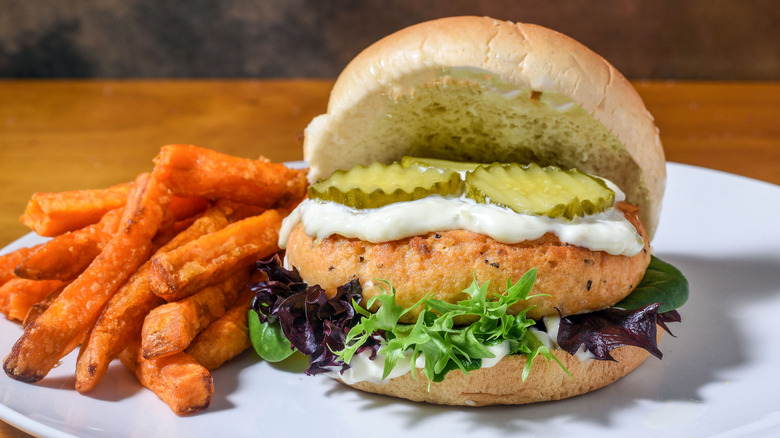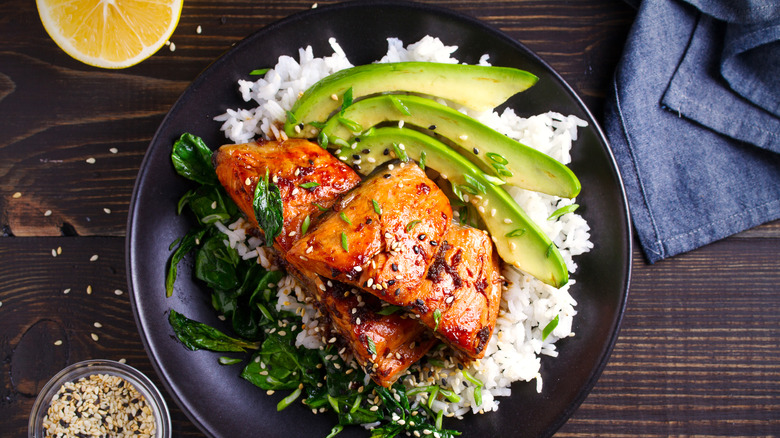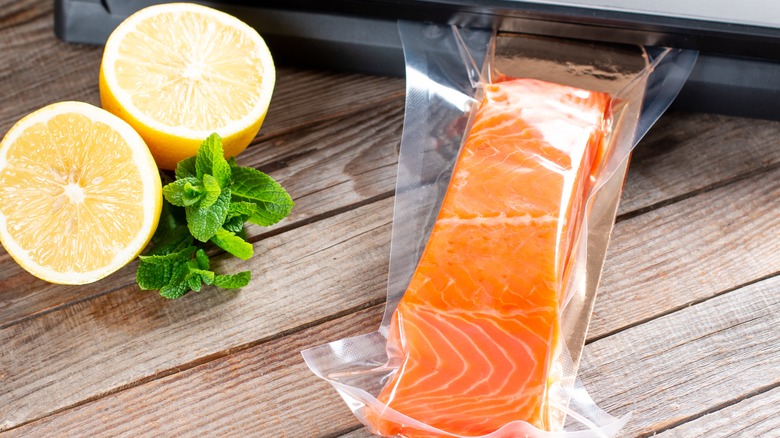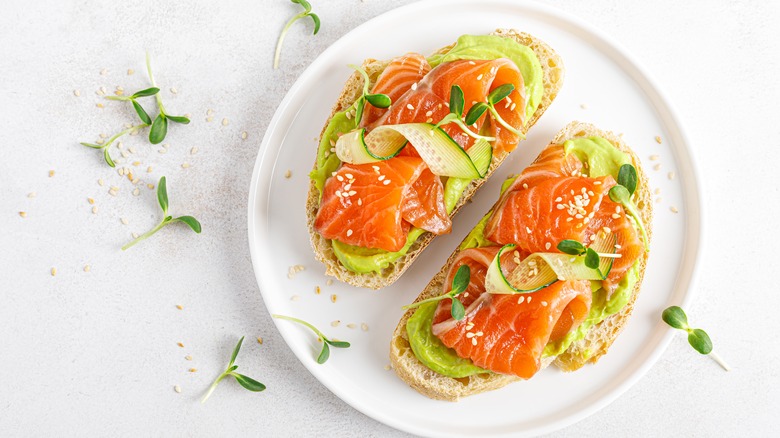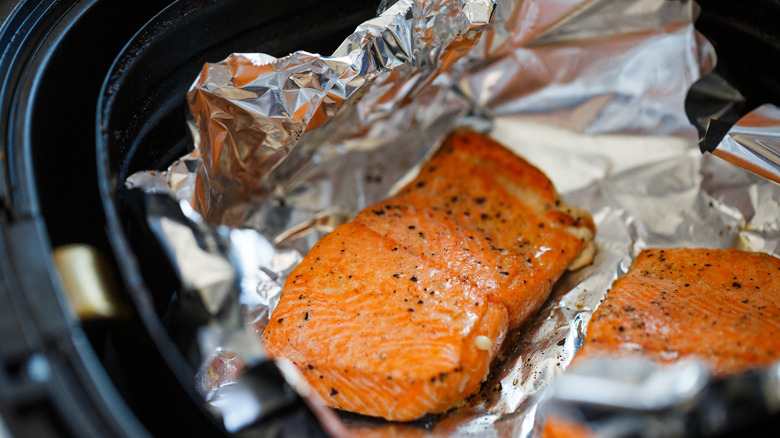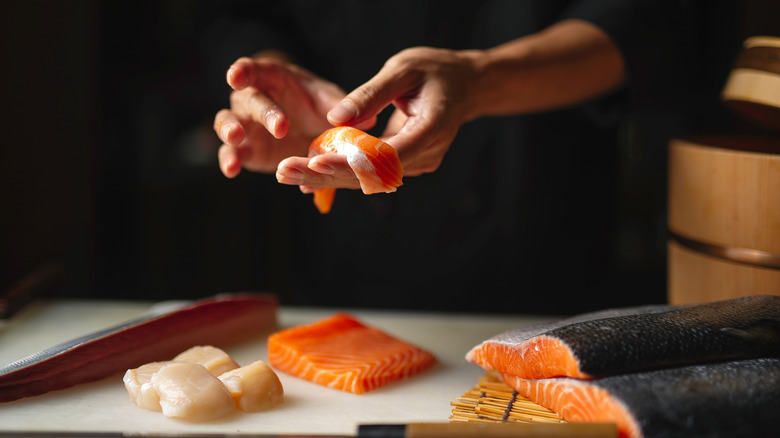12 Ways To Cook Delicious Salmon
Though tuna may hold the distinction, salmon is arguably the true chicken of the sea. It's versatile, abundant, and consumed by the masses. In fact, a National Fisheries Institute study shows that salmon is the second most consumed seafood product in the United States, behind shrimp.
As much as you can't deny salmon's dominance in the seafood industry, this pink-fleshed fish has gained quite a reputation among many food lovers as being boring and drab. (You'll find similar critiques of the humble chicken breast.) Eating the same meals over and over again can make anyone grow tired, but the beauty of a protein like this fish is that there are infinite culinary possibilities.
We're highlighting some of the best methods for cooking salmon and the tips you need to make it delicious every time. Before you give up on America's favorite fish, consider changing up your routine with a different cooking style. Within each category, you can find plenty of ways to make it your own.
Pan-seared
The crispy skin is one of the best parts of eating salmon, but not all cooking methods are created equally to achieve an audible crunch. The ultimate way to execute this skill is pan-searing. Like other proteins, searing fish activates the Maillard reaction, resulting in the much-prized browning and flavor.
A simple tip for getting extra crispy salmon skin is to cook fillets skin-side down the entire time. Make sure the fish (especially the skin) is super dry. Then place the fillets skin-side down in a piping-hot pan coated with oil. Salting the skin ahead of time helps to draw out excess moisture, aiding in crisping the skin. Just be careful not to season the pink flesh too far in advance, as it can leave you with dry fish. You can flip the fillet over for just a few seconds at the end to make sure the surface gets heated, but if you add some extra butter or oil to your pan, it's easy to baste it by spooning the hot liquid over the fish until the top is cooked. You'll know it's done when the fish is opaque throughout and slightly firm to the touch.
There's very little that won't go with a piece of perfectly seared salmon. Simples sides like rice and asparagus come to mind as classic pairings, but give yourself the chance to get creative. Think of different herbs and vegetables to make a fresh salad or try different sauces that fit your tastes.
Baked
Impeccably roasted salmon should be tender and juicy, not dry and flavorless. The most common mistake with baking salmon is overcooking it. With some of the guidance out there, it is not surprising to see why this happens.
The oven temperature as well as the size and thickness of the fillets will dictate cooking time, but you will know it's done when the internal temperature reaches 145 degrees Fahrenheit. For our lemon-garlic baked salmon recipe, we recommend setting the oven to 400 degrees Fahrenheit with a cook time of around 20 minutes. The higher the temperature, the cooking time will shorten, but so does the margin for error. With the oven set to 450, you have to watch closely to ensure you don't overcook the fish. You are also more likely to get that unpleasant albumin (aka the white stuff on salmon) at higher temperatures. When you see that white substance on your salmon, all is not lost; it's simply the coagulation of naturally occurring proteins in the fish, and perfectly safe to eat. You just might not like the look of it.
For best results, roast salmon skin-side down. Even if you don't intend to eat the skin, keeping it attached will help protect the fish from overcooking and limit the occurrence of albumin. Like with pan-searing, baked salmon is a versatile main dish that goes well with a variety of foods but especially roasted vegetables.
Grilled
Fish may not be the first protein that comes to mind for barbecuing, but salmon is very much suited for the grill. If you have found your salmon falls apart on the grates, we have a simple trick to solve your troubles: You should be grilling salmon in foil packets.
Using a foil packet for grilling salmon has several benefits. It helps lock in moisture and will caramelize a glaze without burning the sugars. As an added bonus, your clean-up will be a breeze. For superb grilled salmon, fold a piece of tin foil around the fillets, leaving only a small opening to let excess steam escape. Like the former methods on this list, keeping the skin on the fish will provide an extra layer of protection from the heat. Make sure to place the fillets skin-side down in the foil.
Add the packs to the grill and cook for approximately 15 minutes, but it may take longer based on the size of the fillets. You should get a tender piece of fish with succulent flakes. Now you can try all your favorite grilled salmon recipes without having to vigorously scrape the grates afterward.
Poached
Poaching is an age-old fine dining technique for a reason and using it for salmon will result in a clean, classic look and flavor. It's ideal for when you find yourself with skinless salmon fillets because when you poach fish, you don't have to worry about it drying out without the skin. The salmon will retain moisture and will gently flake apart with gentle pressure from your fork.
Your poached fish will be even more delicious if you follow this one simple trick: Use a flavorful liquid. All you need is water to poach salmon, but it will taste far better if you amp up the flavor in your poaching liquid. Add aromatics and a little vinegar to the water, or substitute the water completely for another liquid, such as wine, cider, or coconut milk. Don't forget to season your poaching liquid with salt. If you season the surface of the fish just before cooking, the salt will wash off in the liquid.
Poached salmon benefits from a spoonful of sauce, such as beurre blanc or creamy dill yogurt. It'll also pair well with a variety of vegetable side dishes, asparagus being one of the most time-honored examples.
En papillote
Adopted from the French language and culinary techniques, en papillote is a style of cooking fish (or meats) enclosed in parchment packets. This term literally means "in paper," and parchment is the more commonly seen vessel for this method. Just like you would with grilling, foil packs can be used to steam fish in the oven. It does not, however, work both ways — parchment paper on the grill is asking to start a fire.
When you cook salmon en papillote, the fish steams inside the packet, resulting in a moist fillet. Cooking fish in parchment paper is quick, easy, and relatively mess-free. You simply cut a piece of parchment into the shape of a heart and arrange the salmon on one side of the paper. You can even add vegetables right onto the parchment, such as thinly shaved zucchini or cherry tomatoes. Make overlapping folds in the paper (as is you were crimping a dumpling) and ensure the packet is entirely sealed. Place the packets on a sheet tray and steam in the oven at 400 degrees Fahrenheit, which will take about 10 to 15 minutes. Then, you can tear right into the packets and enjoy your fish and veggies all at once.
Salmon cakes
It's no secret that Marylanders love their crab cakes. Although they are a mid-Atlantic specialty, the savory seafood discs are found on restaurant menus all over the country. Salmon cakes are a similar concept, but they are given considerably less attention.
A dish with a thousand names, you might also see slight variations called salmon "patties," "fritters," or "croquettes." Whatever you want to call them, this is an excellent way to use up leftover salmon. If you are on a budget you can also make a very affordable dish feel gourmet with canned salmon. While the cost of seafood is generally already high, it is expected that salmon prices will continue to increase due to rising ocean temperatures that affect production.
We developed our recipe for pan-fried salmon croquettes using canned salmon, fresh herbs and vegetables, breadcrumbs, and Old Bay. Salmon cakes yearn for a creamy sauce to accompany them, and a combination of sour cream, lemon, and dill certainly fits the bill.
Salmon burgers
You might think that salmon cakes and salmon burgers are just about the same thing when you look at them, but they have distinct differences. While salmon cakes are made with already cooked salmon, salmon burgers are made from raw, ground fish, similar to a typical beef burger.
Making homemade salmon burgers is great for when you happen to have scraps of raw fish that are too small to cook themselves. For our salmon burger recipe, you'll use a food processor to combine the salmon and all accompanying ingredients before forming them into patties. Be careful not the over-process. The mixture should resemble ground turkey and not a paste.
You can cook salmon burgers on the stovetop in a skillet, but they are also great on the grill. They should only need a few minutes per side to get golden brown on the outside but juicy and tender inside. Serve salmon burgers similarly to standard burgers, but keep in mind the flavor differences in flavors between the two. Salmon burgers, which skew closer to turkey burgers, are great topped with greens and creamy sauces with lots of citrus and herbs. A Greek-style tzatziki would also pair nicely.
Glazed
A versatile technique that can be used with a variety of cooking methods, glazing salmon is a great way to impart added flavor. You can add a glaze to all sorts of salmon dishes from baked to grilled. Simply put, a glaze is a shiny coating on food, and most are made by reducing some combination of sugar and liquid. Glazes tend to add sweetness and sometimes a touch of heat to your fish, but you have to be careful when using this type of sauce. The sugars make them more prone to burning and a scorched glaze will taste bitter and unappetizing.
In our recipe for bourbon glazed salmon, we reduced brown sugar, maple syrup, Dijon mustard, apple cider vinegar, crushed red pepper, garlic, and bourbon until it thickens. Brush the glaze onto the salmon before cooking to ensure it caramelizes in the oven as the fish bakes. The beauty of glazes is that you can try different flavor profiles every time. Just keep in mind that salmon in this style will take a little longer to cook because you have to make the glaze first.
Sous vide
Did you know that salmon is one of the best foods to cook sous vide? If you are new to this type of cooking, it is a technique where you heat food in vacuum-sealed packages in a water bath maintained at a steady temperature by a sous vide machine.
Using sous vide methods, you won't have to worry about overcooking your fish. The controlled temperature means you should get even, tender fish every time. Set your machine at 125 degrees Fahrenheit, and leave the bags of fish in the water bath for 45 minutes. When it's ready, take the fish out of the plastic and sear in a hot pan to still get that crispy skin.
Another benefit of sous vide cooking is that you can amplify the flavor of the fish. The process of vacuum-sealing concentrates whatever ingredients you place into the bags with the salmon. A simple preparation of olive oil, salt, pepper, and a little lemon juice will do the trick, but there are plenty of other flavor profiles at your disposal. Go sweet with maple syrup, salty with soy sauce, tangy with sweet and sour sauce, or spicy with chili sauce like sambal. You can also add vegetables such as asparagus right into the vacuum-seal bags to cook alongside the fish.
Smoked or cured
Smoked salmon and lox are terms that tend to get used interchangeably although they are not quite the same. The real difference between smoked salmon and lox is that the latter is only salt-cured while the former is cured and then smoked. Lox, which comes from the Yiddish word "laks" (which means salmon) is traditionally made only from the salmon belly, while smoked salmon could take be prepared via any part of the fish. Smoked salmon can also be cold-smoked or hot-smoked. When it is cold-smoked, it closely resembles lox, understandably causing linguistic confusion.
Whatever you prefer, smoked or cured salmon is a treat like none other. Its silky, buttery texture and rich taste make it feel like a luxury item. You can even make it yourself if you have a few days to wait for the final results. Whether you go homemade or store-bought that are plenty of ways to make the most out of your prized salmon. Bagels with cream cheese, lox, sliced red onion, and capers are a classic Jewish deli combo. Feel free add whatever toppings you like or even switch out the cream cheese for avocado. Smoked or cured salmon can also be a great salad topper or incorporated into a pasta dish for a buttery finish.
Air-Fried
Cooking salmon in the air fryer is a tricky endeavor, but when done right, it can be one of the most delectable ways to enjoy this fish. The hardest part is preventing salmon from drying out in the air fryer. It is even more crucial in this case to wait until the last moment to salt your salt fillets before cooking them. Salting in advance won't get you the juicy pink flesh you desire. You can also put a piece of foil in your fryer basket to prevent the fish from sticking, and make sure to preheat your air fryer. This will allow the fillets to cook more evenly.
An air fryer can be a great way to enjoy simply cooked salmon, but it also gives you the opportunity to try something unique. Air-fried salmon "nuggets" or "bites" are all the rage right now. Typically coated in a spice blend, such as Cajun seasoning, this trendy dish made with chunks of salmon cooks in just five minutes, and you can use whatever flavors you crave. We've also got an enticing recipe for Korean-style air fryer salmon. Before cooking, the filet is coated with a sweet and spicy gochujang glaze, which caramelizes perfectly after 10 minutes in this handy appliance. It'll have you hooked on air-fried salmon.
Raw preparations
The term cooking typically elicits images of heat: wood-fired ovens, gas stoves, electric cooktops, etc. However, it can also mean the act of preparing food for consumption. When it comes to salmon, raw preparations have just as much merit as cooked techniques. There is no shortage of raw salmon dishes from around the world for you to try.
In Italian cuisine, you've got crudo and carpaccio. In fact, carpaccio is a subcategory of crudo where the fish is sliced or pounded very thin. (Crudo simply means "raw" in Italian.) Travel across the globe to Japan, and you'll find the ever popular sashimi (simply prepared slices of raw fish), nigiri (sliced raw fish over a mound of rice), and sushi (a broader term for a dish of rice wrapped in seaweed with fresh ingredients like seafood, often raw). Another Pacific island, Hawaii offers us poke. Japanese influences are noted in this dish mouthwatering dish that includes cubes of raw fish that are often dressed with ingredients like soy sauce, sesame oil, and topped with sesame seeds.
If you are wondering if it is safe to eat raw salmon, the answer is: it depends. High-quality salmon that was flash-frozen is considered the safest to consume since the super cold temperatures are designed to kill potential parasites.
